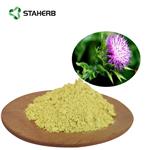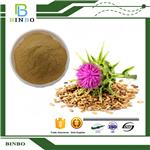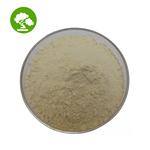Silymarin - Benifits to Skin and Applications in Cosmetics
Mar 9,2022
Introduction
Silymarin is a botanical extract derived from milk thistle. There are several studies that have evaluated individual components of silymarin in dermatology, and fewer studies that have evaluated the properties of unfractionated silymarin in skin.
Silymarin Antioxidant Properties in Skin
Silymarin is a naturally occurring compound that has demonstrated anti-oxidant properties in skin cells. Flavonoids and flavonolignans represent the main classes of components that comprise silymarin, and studies have demonstrated the ability of both of these components to reduce the generation of hydrogen peroxide in keratinocytes and also limit hydrogen peroxide associated skin cell death. Our research group recently demonstrated the biphasic dose dependent anti-oxidant function of unfractionated silymarin in normal human skin fibroblasts in vitro. It was interesting that the lowest dose, 0.0001% of silymarin, produced the best anti-oxidant effect in our in vitro model of hydrogen peroxide induced oxidative stress. This work is particularly important, as it highlights the importance of preclinical research to select the appropriate concentration of anti-oxidants to best protect against oxidative stress in skin. This premise of preclinical testing of anti-oxidant capability in vitro is not limited to silymarin alone, and extends to other anti-oxidants, wherein preclinical testing can help optimize the selection of the concentrations of natural products to be incorporated into topical cosmeceuticals for patient use. To our knowledge, there are no published studies that have evaluated the anti-oxidant capabilities of silymarin on human skin in vivo.

Another research group recently demonstrated the anti-oxidant abilities of silymarin in mouse skin derived CD11b+ lymphocytes.4 In this study, silymarin was able to decrease reactive oxygen species production in ultraviolet (UV)-induced oxidative stress in these infiltrating lymphocytes. In conjunction with our silymarin research, this research demonstrates that silymarin is able to function as an anti-oxidant through inhibition of reactive oxygen species generation in a variety of skin cells.
Silymarin Photoprotective Properties in Skin
Silymarin has demonstrated photoprotective properties in skin animal models. In a murine model, silymarin treatment decreased UVB-generated intracellular hydrogen peroxide production in the epidermal and dermal layers of the skin.5 Furthermore, in this same study, silymarin was able to protect against UVB-induced sunburn.
Furthermore, silibinin, a chief component of silymarin, was shown to demonstrate photoprotective properties in human skin via modulation of reactive oxygen species free radical-associated pathways. An additional study demonstrated that silymarin was able to protect against UVB-induced keratinocyte apoptosis via anti-oxidant mechanisms and silymarin facilitated increased repair of UVB-induced DNA damage by upregulation of nucleotide excision repair.
Silymarin Anticancer Properties in Skin
Silymarin has demonstrated anti-cancer properties in cutaneous models. We anticipate that due to silymarin’s photoprotective and anti-cancer properties, silymarin will begin to feature prominently in future topicals aimed at ultraviolet sunscreen and anti-cancer protection. In a murine study, silymarin reduced UVB-induced melanoma tumor incidence and volume. Topical application of silymarin in other murine skin models have demonstrated mechanistic anti-cancer properties through reduction of 12-O-tetradecanoylphorbol-13-acetate (TPA)-induced ornithine decarboxylase (ODC), a well-studied compound associated with tumor promotion via effects on the cell cycle.
Silymarin Anti-Fibrotic Properties in Skin
Silymarin has demonstrated anti-fibrotic properties in in vitro models. Treatment of primary human skin fibroblasts with silymarin led to downregulation of type I collagen synthesis.11 This downregulation in collagen was demonstrated to result from inhibition of the TGF-beta pathway by regulation of Smad2/3 signaling.11 In addition, silymarin increased matrix metalloproteinase (MMP)-1 and MMP-2 levels. These findings suggest that silymarin may hold potential for treatment or prevention of fibrotic diseases, such as keloids and hypertrophic scars.
The scientific foundation for the inclusion of silymarin in topical products for the purpose of antioxidation, anti-cancer, anti-fibrotic, and photoprotection is well supported by several preclinical studies outlined in this chapter. We anticipate and look forward to future translational research demonstrating the beneficial properties in human skin clinically.
REFERENCES
1. Svobodova A, Walterova D, Psotova J. Influence of silymarin and its flavonolignans on H(2)O(2)-induced
oxidative stress in human keratinocytes and mouse fibroblasts. Burns 2006;32:973–9.
2. Svobodova A, Zdarilova A, Walterova D, Vostalova J. Flavonolignans from Silybum marianum moderate
UVA-induced oxidative damage to HaCaT keratinocytes. J Dermatol Sci 2007;48:213–24.
3. Mamalis A, Nguyen DH, Brody N, Jagdeo J. The active natural anti-oxidant properties of chamomile,
milk thistle, and halophilic bacterial components in human skin in vitro. J Drugs in Dermatol
2013;12:780–4.
4. Katiyar SK, Meleth S, Sharma SD. Silymarin, a flavonoid from milk thistle (Silybum marianum L.), inhibits
UV-induced oxidative stress through targeting infiltrating CD11b+ cells in mouse skin. Photochem
Photobiol 2008;84:266–71.
5. Katiyar SK. Treatment of silymarin, a plant flavonoid, prevents ultraviolet light-induced immune suppression
and oxidative stress in mouse skin. Int J Oncol 2002;21:1213–22.
6. Narayanapillai S, Agarwal C, Deep G, Agarwal R. Silibinin inhibits ultraviolet B radiation-induced
DNA-damage and apoptosis by enhancing interleukin-12 expression in JB6 cells and SKH-1 hairless
mouse skin. Mol Carcinog 2014;53(6):471–9.
7. Narayanapillai S, Agarwal C, Tilley C, Agarwal R. Silibinin is a potent sensitizer of UVA radiationinduced
oxidative stress and apoptosis in human keratinocyte HaCaT cells. Photochem Photobiol 2012;
88:1135–40.
8. Katiyar SK, Mantena SK, Meeran SM. Silymarin protects epidermal keratinocytes from ultraviolet
radiation-induced apoptosis and DNA damage by nucleotide excision repair mechanism. PloS One
2011;6:e21410.
9. Agarwal R, Katiyar SK, Lundgren DW, Mukhtar H. Inhibitory effect of silymarin, an anti-hepatotoxic
flavonoid, on 12-O-tetradecanoylphorbol-13-acetate-induced epidermal ornithine decarboxylase activity
and mRNA in SENCAR mice. Carcinogenesis 1994;15:1099–103.
10. Mallikarjuna G, Dhanalakshmi S, Singh RP, Agarwal C, Agarwal R. Silibinin protects against photocarcinogenesis
via modulation of cell cycle regulators, mitogen-activated protein kinases, and Akt signaling.
Cancer Res 2004;64:6349–56.
11. Cho JW, Il KJ, Lee KS. Downregulation of type I collagen expression in silibinin-treated human skin
fibroblasts by blocking the activation of Smad2/3-dependent signaling pathways: Potential therapeutic
use in the chemoprevention of keloids. Int J Mol Med 2013;31:1148–52.
- Related articles
- Related Qustion
- Silymarin: Treatments for diseases and Side effects Dec 4, 2023
Antiviral activity of silymarin and its derivatives against a wide range of viruses, including flaviviruses (hepatitis C virus, dengue virus), togaviruses (chikungunya virus, Mayaro virus), influenza viruses, human immunodeficiency viruses
Sodium bicarbonate, commonly known as baking soda, has the chemical formula NaHCO3....
Mar 9,2022APINiacinamide, also known as nicotinamide, is an increasingly popular component of topical cosmeceuticals. It has shown a wide variety of benefits such as improving epidermal barrier function and therefore inflammatory dermatoses.....
Mar 9,2022Vitamins and Minerals medicinesSilymarin
65666-07-1You may like
- The new research on Silychristin
Apr 29, 2024
- What is chlorella spermidine?
Apr 19, 2024
- Does icariin help with pain?
Apr 18, 2024
- Silymarin
-

- $0.00 / 1kg
- 2024-05-24
- CAS:65666-07-1
- Min. Order: 1kg
- Purity: 98%
- Supply Ability: 1000kg
- Silymarin
-

- $0.00 / 25kg
- 2024-04-22
- CAS:65666-07-1
- Min. Order: 1kg
- Purity: hplc 20-35% UV 40-50%
- Supply Ability: 1000 kg
- Silymarin
-

- $0.00 / 25kg
- 2024-04-12
- CAS:65666-07-1
- Min. Order: 1kg
- Purity: 99%
- Supply Ability: 2000ton




